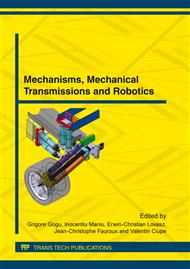p.1
p.11
p.19
p.29
p.37
p.47
p.57
p.67
Kinematic Synthesis of a Step Mechanism Based on a Five Bar Linkage
Abstract:
On the basis of a five bar linkage it is possible to generate actinomorphic coupler curves if certain conditions, related to the kinematic dimensions and the gear ratio between the two cranks, are fulfilled. These symmetric coupler curves can then be used to realize a step mechanism by adding two additional links, taking advantage of the typical curvature characteristics of the generated coupler curve The following article starts with a short literature survey about five bar linkages in general and their use as dwell or step mechanisms in particular. Then it will be shown how the curvature properties of the coupler curves generated by five bar linkages can be determined by graphical means. It will be shown how this procedure can be advantageously applied with the help of an interactive geometry program, using the geometric determination of the curvature properties, such that an optimal step mechanism can be derived.
Info:
Periodical:
Pages:
1-10
Citation:
Online since:
March 2012
Authors:
Price:
Сopyright:
© 2012 Trans Tech Publications Ltd. All Rights Reserved
Share:
Citation:


